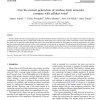Free Online Productivity Tools
i2Speak
i2Symbol
i2OCR
iTex2Img
iWeb2Print
iWeb2Shot
i2Type
iPdf2Split
iPdf2Merge
i2Bopomofo
i2Arabic
i2Style
i2Image
i2PDF
iLatex2Rtf
Sci2ools
COMCOM
2008
2008
Can the current generation of wireless mesh networks compete with cellular voice?
Wireless mesh networks are being deployed to provide broadband wireless connectivity to city-wide hotspots. The typical architecture in these deployments thus far is a single-radio architecture: mesh nodes carry only one radio, which is used both to receive the traffic from the clients and to relay this traffic through the mesh to the wired Internet gateway.In this paper, we study the performance of a representative single-radio mesh network both in a live setup and in a laboratory environment. We characterize the performance of different applications (e.g. VoIP), and study some key challenges of mesh networks such as the fairness in bandwidth allocation and hidden node terminal. Finally, we compare the results of the study with traditional cellular networks, and discuss various options to enhance the performance of wireless mesh networks in the future.
| Added | 09 Dec 2010 |
| Updated | 09 Dec 2010 |
| Type | Journal |
| Year | 2008 |
| Where | COMCOM |
| Authors | Andres Arjona, Cédric Westphal, Jukka Manner, Antti Ylä-Jääski, Sami Takala |
Comments (0)

